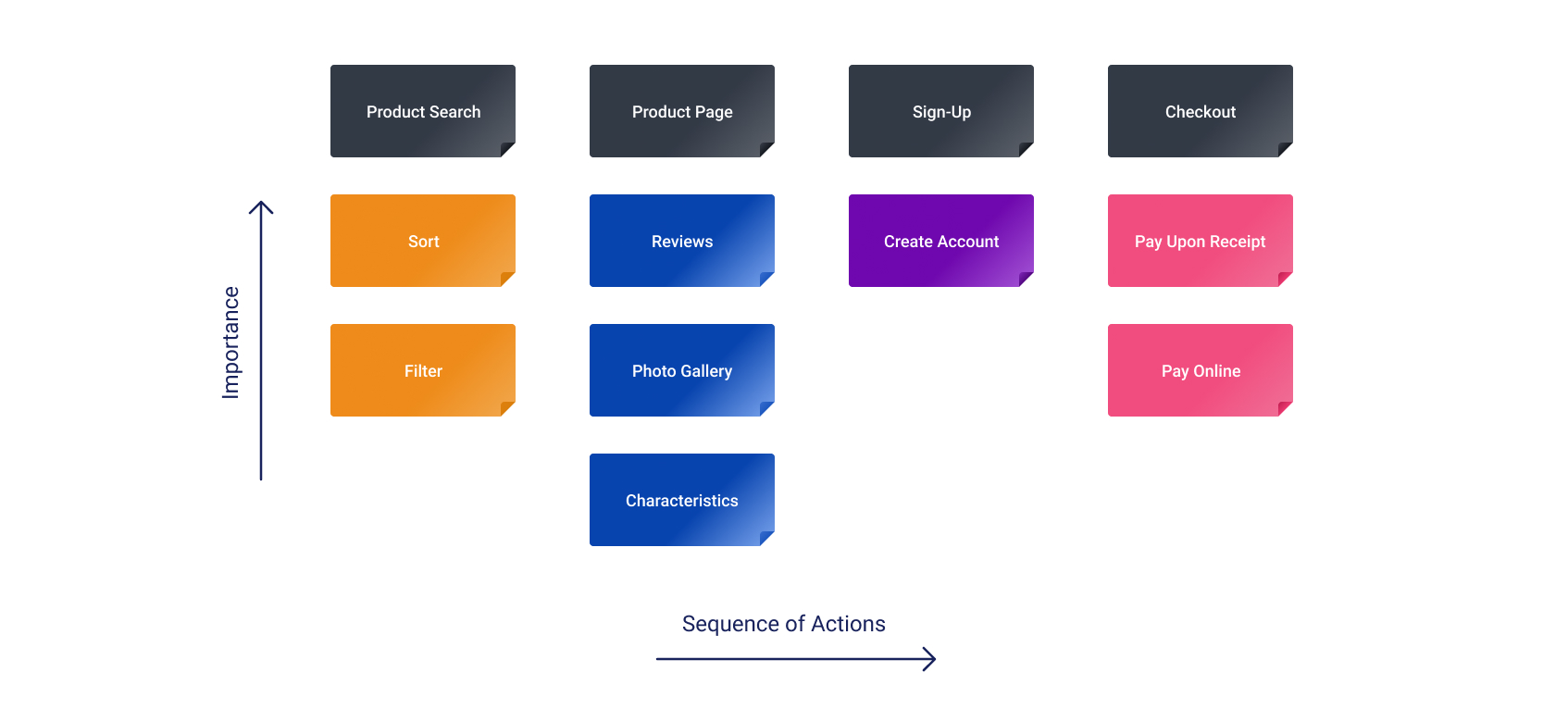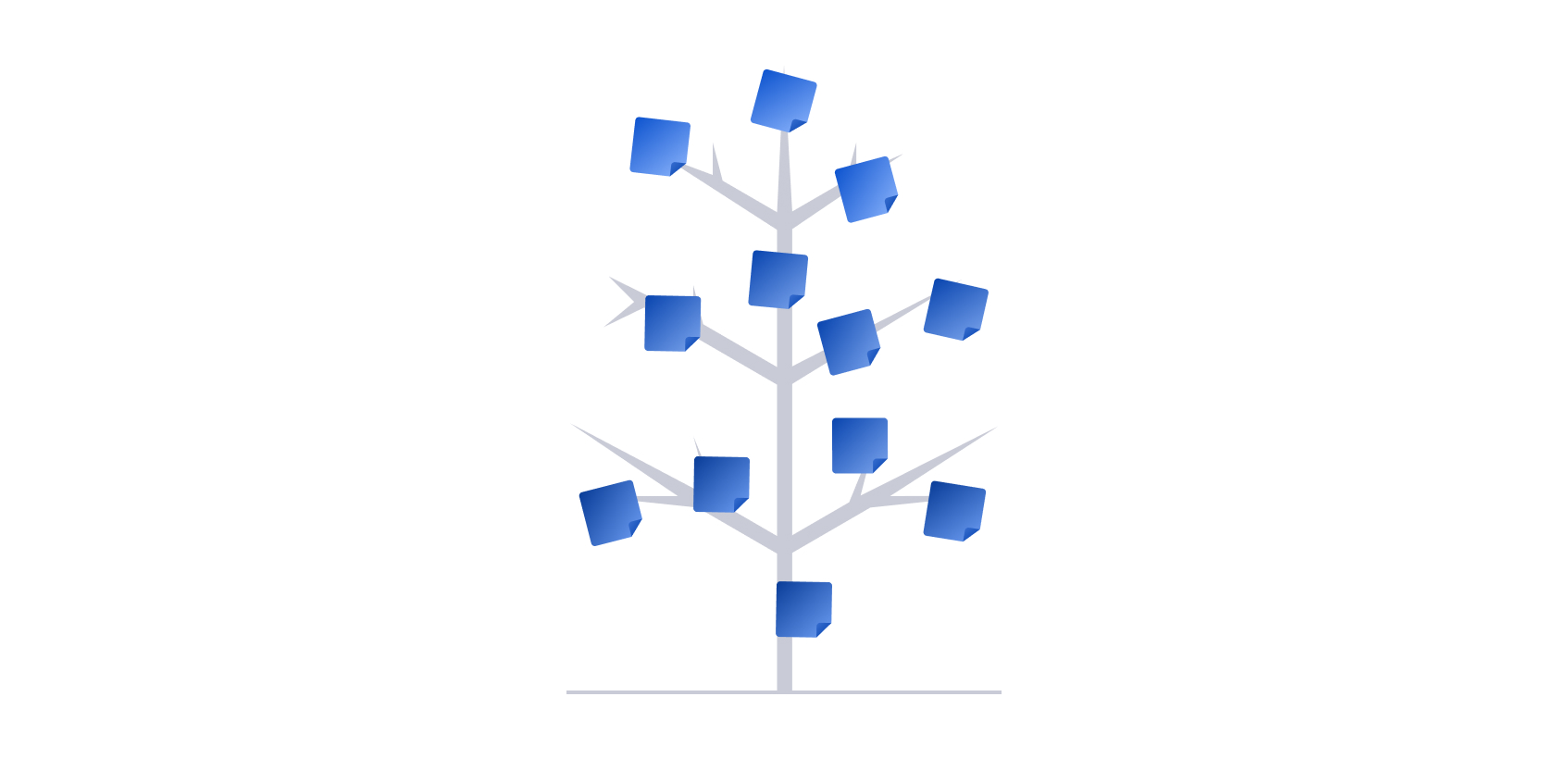When you undergo the initial stages of your project, you will inevitably face the necessity to determine the actions that should be done most urgently. And different stakeholders may have absolutely different standpoints, which may become a reason for long debates or even disputes. To avoid undesirable consequences and make better-grounded decisions, product managers use a set of techniques which allows them to consider the project from different perspectives and define the most appropriate roadmap.
In the previous chapter we considered four popular prioritization frameworks used by product managers to have a clear understanding which actions should be done first and which can be postponed. They are: RICE, Kano Model, Value vs Effort and MoSCoW method. In this chapter we will speak about other prioritization frameworks which were not mentioned previously, and define their strong and weak points.
Story Mapping
This kind of framework is of great help if you create an MVP (minimum viable product) and have a wide set of tasks to fulfill. In this case the way of visualisation through the use of Story Mapping will allow you to “compartmentalize” the priorities of your product and gain a clear vision of what should be implemented first. This method presupposes the use of horizontal and vertical axes, and also sticky notes. Horizontal axis represents the sequence of use, which means that tasks are placed in the sequence of actions taken by users. Vertical axis represents the importance, and sticky notes marked with tasks are placed from top to bottom, depending on importance. The example of story mapping framework is below:
 Owing to the story mapping the list of tasks is divided into steps taken by users, and each feature has its priority (the lower feature is placed, the lower is its priority from the user’s standpoint).
Owing to the story mapping the list of tasks is divided into steps taken by users, and each feature has its priority (the lower feature is placed, the lower is its priority from the user’s standpoint).
This framework is a great tool to gain the visual representation of the sequence of actions taken by users when they use your product. Such an approach is collaborative and centered on user experience, which allows the team to determine the functionality which should be implemented primarily in the most effective way.
Nevertheless, it is impossible to make do with a story mapping framework only. The main disadvantage of the method which should be taken into consideration, is that it does not take into account such factors as business value and complexity. Therefore it should be combined with other prioritization models to gain an optimal result.
The Product Tree
To make the prioritization process more entertaining and gamified, you can consider using the product tree prioritization framework. It represents a tree, where trunk means the key or already existing features; branches stand for primary product or system functionalities; roots imply technical requirements or infrastructure; leaves pose new ideas for product features.
 The main goal of the product tree prioritization framework is to “grow” a product in accordance with customer’s requirements, which would ensure that the outcome would bring the highest value to a company. To do that, it is necessary to work in close collaboration with stakeholders through asking them to place their preferred product features on a tree. Such an approach will give you an insight on the functions that require more focus, which of them should be changed, and which can be postponed and not released in the near future.
The main goal of the product tree prioritization framework is to “grow” a product in accordance with customer’s requirements, which would ensure that the outcome would bring the highest value to a company. To do that, it is necessary to work in close collaboration with stakeholders through asking them to place their preferred product features on a tree. Such an approach will give you an insight on the functions that require more focus, which of them should be changed, and which can be postponed and not released in the near future.
Nice thing about the product tree prioritization framework is that it is highly collaborative. During its use you have a valuable opportunity to gain an insight into a client’s vision which helps your team to build a product in compliance with the customer’s requirements.
As for the most evident disadvantages, as this method is highly collaborative, it is inevitably time-consuming. Another drawback is that the framework does not provide any quantitative values for how to rank this or that feature, since its main purpose is to give a general picture of the product.
Cost of Delay
The expression “time is money” has not lost its relevance since the 18th century when it was said by Benjamin Franklin. The Cost of Delay prioritization framework is used to determine how time and expenses influence the desired outcome. This method presupposes discussion of the following points:
- How beneficial would this feature be if the product had it right now?
- How would our income have increased if the feature had been implemented earlier?
- What would our expenses be if the feature was introduced later than planned?
Let’s try to determine which feature has a higher priority in comparison with another through the use of the simple example. Imagine that you have a feature to develop, which requires two months to build it, and the cost of the delay is 40000 USD weekly. Another feature also requires two months work, but the cost of delay is significantly lower — 20000 USD per week. Therefore, we can come to the conclusion that the first feature is of higher priority than the second one.
The main advantage of the Cost of Delay approach is that it provides a picture of how the features should be prioritized from the standpoint of the expenses. Owing to it, managers are able to make more informed decisions based on the values they have for a company. But meanwhile, the criteria of cost determination are based on assumptions and gut-feelings which may lead to serious disagreements within the team, and this factor is the key disadvantage of the Cost of Delay prioritization method.
Buy a Feature
To make the prioritization process more informal and entertaining, there exists such a framework as Buy a Feature. When you involve the stakeholders in the game, you gain a possibility to make a quantitative estimate of the cost of the feature for the end-users. The method consists of the following steps:
- Make a shortlist of features or ideas and estimate their costs on the basis of required time and effort for its creation.
- Form a group (up to 8 people consisting of your customers or inner team members) and define the amount of money they can spend to “purchase” the feature.
- Ask the members of your group to buy “features” they consider the most essential. Some participants choose only one feature and give all money for it, some distribute cash among several functions.
- Ask each participant to explain his or her choice.
- Create a ranked list of features taking into consideration the amount of money spent on each of them.
Buy a Feature approach presupposes that some features have a price which would be too high to be paid by only one participant. This fact should motivate the team members to cooperate and pool the existing resources.
This approach can be a great alternative to boring surveys. Unlike an ordinary questionnaire, Buy a Feature game makes stakeholders to consider the importance of each offered function more carefully, which is the great advantage of this approach.
The main challenge of the method is that you can include only the functions you have already decided to add in your future product. Also, you will have to find time suitable for each participant which can be a real challenge if the group is pretty big.
Conclusions
There is a plethora of various prioritization frameworks applied by product managers besides the described approaches. Although it is completely impossible to rely on these approaches only when dealing with prioritization, the use of any of them will facilitate reaching of the agreement between the stakeholders. It will help to make bias-free data-driven and more informed decisions considering tasks distribution and resource allocation.
Please contact us if you need the consultation considering your project, our experts will be glad to assist.